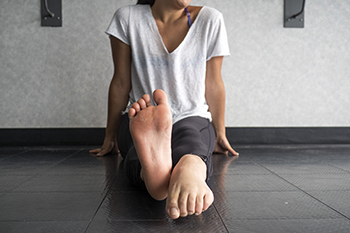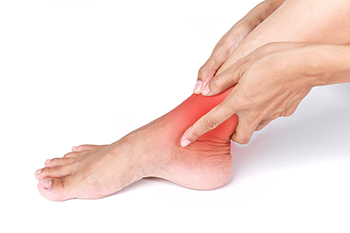
Every time you press your foot down on the accelerator of the car, nine muscles in your ankle, foot, and leg are used to accomplish this task. Additionally, very time you stand on tiptoe to reach something on a high shelf, you need these same muscles to help you to accomplish that. Dancers and many athletes, such as basketball and soccer players, depend on plantar flexion to extend their feet. This action is called flexing the muscles, and an injury to any of the muscles involved can make it painful and difficult to extend the foot. Ankle sprains and fractures are the main conditions that inhibit plantar flexion. When the ankle bones and muscles are injured, the result is swelling that reduces the range of motion. Three actions can help to prevent these types of injuries. First, it is beneficial to wear shoes that fit properly, and avoiding high heels which do not support the ankle. Secondly, perform exercises that strengthen those muscles in the legs, ankles, and feet which support plantar flexion. And lastly, consult a podiatrist who can provide you with tips on how to preserve ankle strength and support.
If you have any concerns about your feet, contact Dean Kim, DPM from Greater Texas Foot & Ankle Specialist. Our doctor can provide the care you need to keep you pain-free and on your feet.
Biomechanics in Podiatry
Podiatric biomechanics is a particular sector of specialty podiatry with licensed practitioners who are trained to diagnose and treat conditions affecting the foot, ankle and lower leg. Biomechanics deals with the forces that act against the body, causing an interference with the biological structures. It focuses on the movement of the ankle, the foot and the forces that interact with them.
A History of Biomechanics
- Biomechanics dates back to the BC era in Egypt where evidence of professional foot care has been recorded.
- In 1974, biomechanics gained a higher profile from the studies of Merton Root, who claimed that by changing or controlling the forces between the ankle and the foot, corrections or conditions could be implemented to gain strength and coordination in the area.
Modern technological improvements are based on past theories and therapeutic processes that provide a better understanding of podiatric concepts for biomechanics. Computers can provide accurate information about the forces and patterns of the feet and lower legs.
Understanding biomechanics of the feet can help improve and eliminate pain, stopping further stress to the foot.
If you have any questions please feel free to contact our office located in Frisco, TX . We offer the newest diagnostic and treatment technologies for all your foot and ankle needs.





